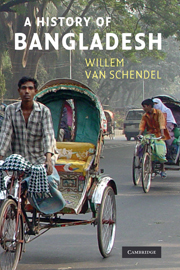Book contents
- Frontmatter
- Contents
- List of plates
- List of maps and figures
- Acknowledgements
- Timeline
- Introduction
- PART I THE LONG VIEW
- PART II COLONIAL ENCOUNTERS
- PART III BECOMING EAST PAKISTAN
- PART IV WAR AND THE BIRTH OF BANGLADESH
- PART V INDEPENDENT BANGLADESH
- Conclusion
- Bangladesh district maps
- Key political figures since 1947
- Glossary of Bengali terms
- Notes
- Bibliography
- Index
Introduction
Published online by Cambridge University Press: 05 February 2015
- Frontmatter
- Contents
- List of plates
- List of maps and figures
- Acknowledgements
- Timeline
- Introduction
- PART I THE LONG VIEW
- PART II COLONIAL ENCOUNTERS
- PART III BECOMING EAST PAKISTAN
- PART IV WAR AND THE BIRTH OF BANGLADESH
- PART V INDEPENDENT BANGLADESH
- Conclusion
- Bangladesh district maps
- Key political figures since 1947
- Glossary of Bengali terms
- Notes
- Bibliography
- Index
Summary
This is a book about the amazing twists and turns that have produced contemporary Bangladeshi society. It is intended for general readers and for students who are beginning to study the subject. Those who are familiar with the story will find my account highly selective. My aim has been to present an overview and to help readers get a sense of how Bangladesh came to be what it is today.
How to write a history of Bangladesh? At first glance, the country does not seem to have much of a history. In 1930 not even the boldest visionary could have imagined it, and by 1950 it was merely a gleam in the eyes of a few activists. Only in the 1970s did Bangladesh emerge as a state and a nation. There was nothing preordained about this emergence – in fact, it took most people by surprise.
Even so, you cannot make sense of contemporary Bangladesh unless you understand its history long before those last few decades. How have long-term processes shaped the society that we know as Bangladesh today? It is a complicated and spectacular tale even if you follow only a few main threads, as I have done. I have greatly compressed the story. To give you an idea: each page of this book stands for about a million people who have historically lived in what is now Bangladesh. This is, by any standard, a huge society folded into a small area.
- Type
- Chapter
- Information
- A History of Bangladesh , pp. xxv - xxviPublisher: Cambridge University PressPrint publication year: 2009



